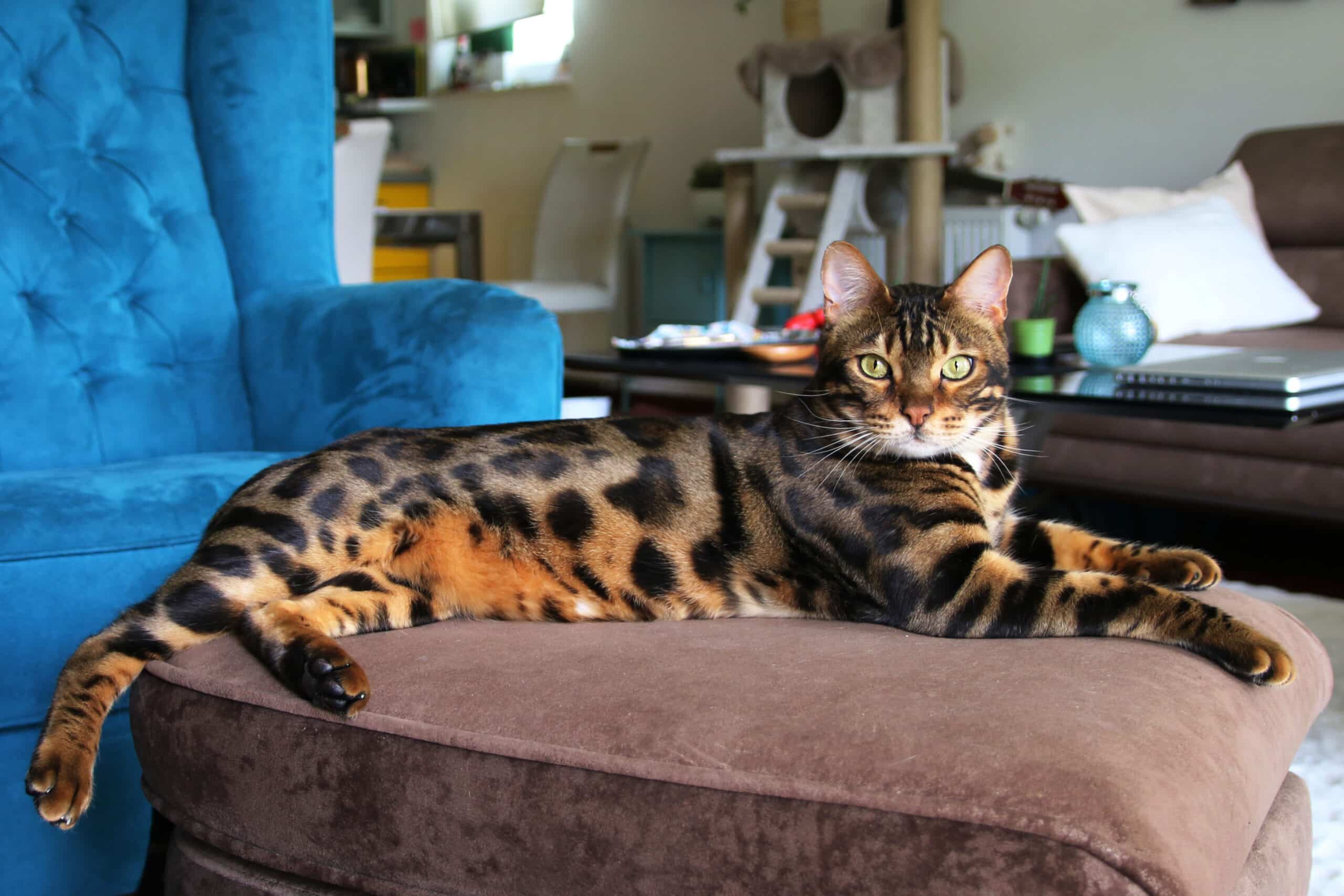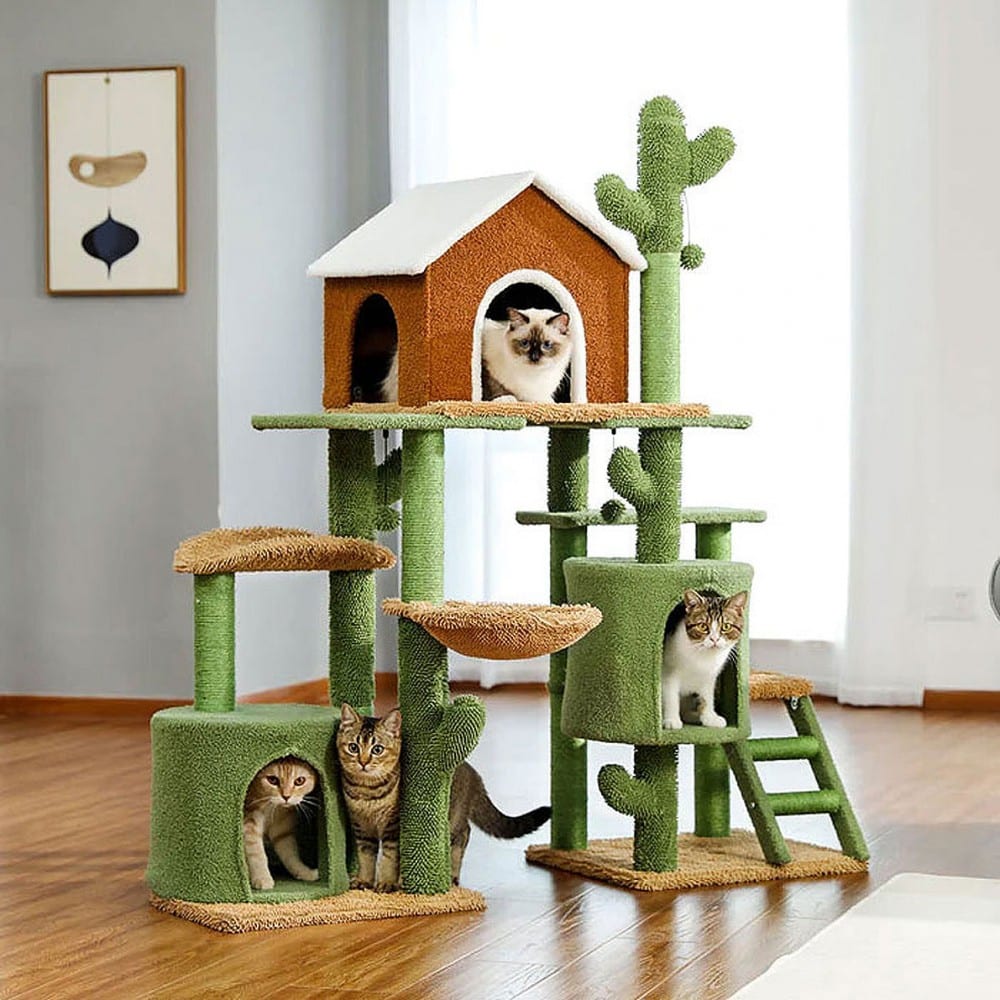Spotting a Miniature Leopard? Think Again – It’s a Bengal Cat! With a look echoing their wildcat lineage, Bengals not only captivate with their exotic charm but also make wonderful and safe family companions.
The Origin Story of Bengal Cats: A Blend of Wild and Tame
Tracing back to the 1960s, the Bengal cat’s inception is credited to Jean Mill, a Californian breeder. She pioneered the Bengal breed by mating a Domestic Shorthair with an Asian Leopard cat in 1963. In the grand tapestry of feline history, Bengals are newcomers, especially when juxtaposed against ancient breeds like the Persian cats, which date back to the 1600s.
Originating from Asia, Asian Leopard cats are wild creatures roughly the size of our household felines. It’s evident that Bengal cats have borrowed a rich tapestry of traits from their wild ancestors, including their iconic spots, vivacious spirit, and a unique penchant for water play.
Bengal Cat Size

Typically falling within the medium to large category, Bengal cats usually weigh between 8-15 pounds and stand about 13-16 inches tall. However, remember that these figures are averages, and individual Bengals can certainly vary in size.
Read:
-
The 20 Best Gifts for Cats
-
15 Cactus Cat Scratchers & Cat Trees for Southwestern Flair
-
12 Best Cat Enrichment Toys in 2024 – Reviews & Top Picks
-
Best 12 Toys Your Bengal Cat Will Love!
A Leopard-Like Look
Bengal cats captivate onlookers with their remarkable leopard-inspired spots or rosettes. These distinctive markings can manifest in hues like rust, chocolate brown, or even black. The canvas of their coat is just as diverse, presenting in shades ranging from golden and rust to sand and ivory. A unique trait in some Bengals is their fur’s shimmer, giving off a glittered glow when it catches the light.
Sporting a compact, rounded face, the Bengal’s large eyes and pronounced facial patterns leave a lasting impression. Their physique mirrors the power and elegance of their Asian Leopard forebears – robust and sleek. The design of their legs, with the hind ones being slightly longer, contributes to their fluid and agile gait.
Bengal Cat Temperament
While a cat’s disposition often reflects its environment and past encounters, Bengal cats carry unique traits rooted in their wild lineage. Typically, Bengals exhibit a keen intelligence, vibrant energy, unwavering confidence, and a constant state of alertness – reminiscent of their jungle-dwelling ancestors!
A Fun and Challenging Pet
Bengal cats overflow with zest, craving regular interaction, which positions them as both entertaining yet demanding pets. They’re an ideal fit for individuals with an active lifestyle who can invest time in daily engagement. Renowned for their playful nature, Bengals relish games like fetch or chase and are quick learners when it comes to tricks.
When Bengal cats aren’t sufficiently stimulated, they might exhibit signs of boredom or agitation, potentially resulting in undesired behaviors. They could resort to scratching furniture or vocalizing more than usual. Thanks to their dexterous paws, Bengals have a knack for exploring, which might include rummaging through your drawers or playfully emptying your kitchen cabinets. Ensuring they have adequate play and interaction can help mitigate such antics.
Bengal Cats and Water
Drawing from their Asian Leopard cat lineage, Bengal cats have a unique affinity for water. It’s not unusual for a Bengal to willingly join you in the shower or take a playful dip in a bathtub. If you’re looking to keep your Bengal amused, consider investing in a pet water fountain.
However, their aquatic curiosity could spell danger for aquarium inhabitants. Bengal cats might not hesitate to reach into a fish tank, enticed by the potential play or snack. Given their strong predatory instincts, it’s also wise to ensure smaller pets, such as hamsters or rabbits, are securely sheltered from these curious felines.

Other Fun Facts About Bengal Cats
The captivating allure of Bengal cats extends beyond their love for water. Here are some fascinating details about these felines:
- Originally termed “Safari Cats,” it wasn’t until the 1970s that they adopted the name “Bengal,” drawing inspiration from the Asian Leopard cat’s scientific moniker, Prionailurus bengalensis.
- Their exotic wildcat appearance has always been in demand. Highlighting this, a Bengal cat in London once fetched a staggering $50,000, garnering them the epithet “Rolls Royce of cats.”
- Their vocalizations aren’t your usual cat meows. Instead, they produce a distinctive raspy sound, sometimes resembling a bark.
- Blessed with dexterous paws, it’s not uncommon for Bengal cats to playfully toggle light switches.
Read:
-
The 20 Best Gifts for Cats
-
15 Cactus Cat Scratchers & Cat Trees for Southwestern Flair
-
12 Best Cat Enrichment Toys in 2024 – Reviews & Top Picks
-
Best 12 Toys Your Bengal Cat Will Love!
Bengal Cat Names
Finding the perfect name for a new feline addition can be challenging, particularly when striving for family consensus. For a Bengal cat, considering their wild heritage might inspire names like Leo, Simba, Hunter, or Tigey. Alternatively, drawing from their unique coat patterns, names such as Spot, Patches, Speckles, or Copper might be fitting.
Common Health Concerns for Bengal Cats
While Bengal cats generally enjoy good health and can live between 12 to 16 years with proper care, they are not immune to certain ailments.
Here are some of the frequent health concerns reported by Bengal cat owners:
- Lymphoma: A cancer originating in the lymphocytes, which are white blood cells linked to the immune system.
- Ear Infections: A prevalent issue in cats, it’s easily treatable, especially when detected early, usually with medicated drops.
- Eye Disorders: Conjunctivitis, often referred to as pink eye, stands out as the most reported feline eye ailment.
- Weight Fluctuations: A noticeable drop in weight could signal various issues, ranging from stress-induced anxiety to underlying health conditions.
- Urinary Problems: These can be due to various causes, from urinary stones to conditions like Feline Interstitial Cystitis (FIC).
- Digestive Concerns: Stomach disturbances can arise from numerous sources, including harmful plant ingestion or more severe conditions like pancreatitis.
Read: Bengal Cat Health Problems

Behavioral Issues in Bengal Cats
Often, Bengal cat owners report behavioral concerns. These issues often surface when these cats don’t receive the ample stimulation and engagement they thrive on.
Caring for a Bengal Cat: Tips and Tricks
Bengal cats, like all felines, need the basics: a nutritious diet, regular nail trims, and dental care. Yet, caring for a Bengal comes with its unique nuances:
- Grooming: Bengals have a lower tendency to shed and often groom themselves well. However, regular brushing is beneficial for their coat health. If they dive into a particularly messy adventure, a gentle bath may be necessary.
- Stimulation: Enhance their environment with cat-friendly puzzle toys or self-activated interactive toys to keep their sharp minds occupied.
- Playtime on a Budget: Simple household items like paper bags, boxes, or ping pong balls can be fantastic playthings. For DIY enthusiasts, consider crafting homemade cat toys.
- The Vertical Dimension: Bengals have an inherent love for heights. Introduce durable climbing trees, tall scratching pillars, or window perches to satiate their climbing urges.
Above all, the key to a happy Bengal cat is abundant affection and attention. Give them the love they yearn for and enjoy the companionship!
Read more:
-
The 20 Best Gifts for Cats
-
15 Cactus Cat Scratchers & Cat Trees for Southwestern Flair
-
12 Best Cat Enrichment Toys in 2024 – Reviews & Top Picks
-
Best 12 Toys Your Bengal Cat Will Love!







